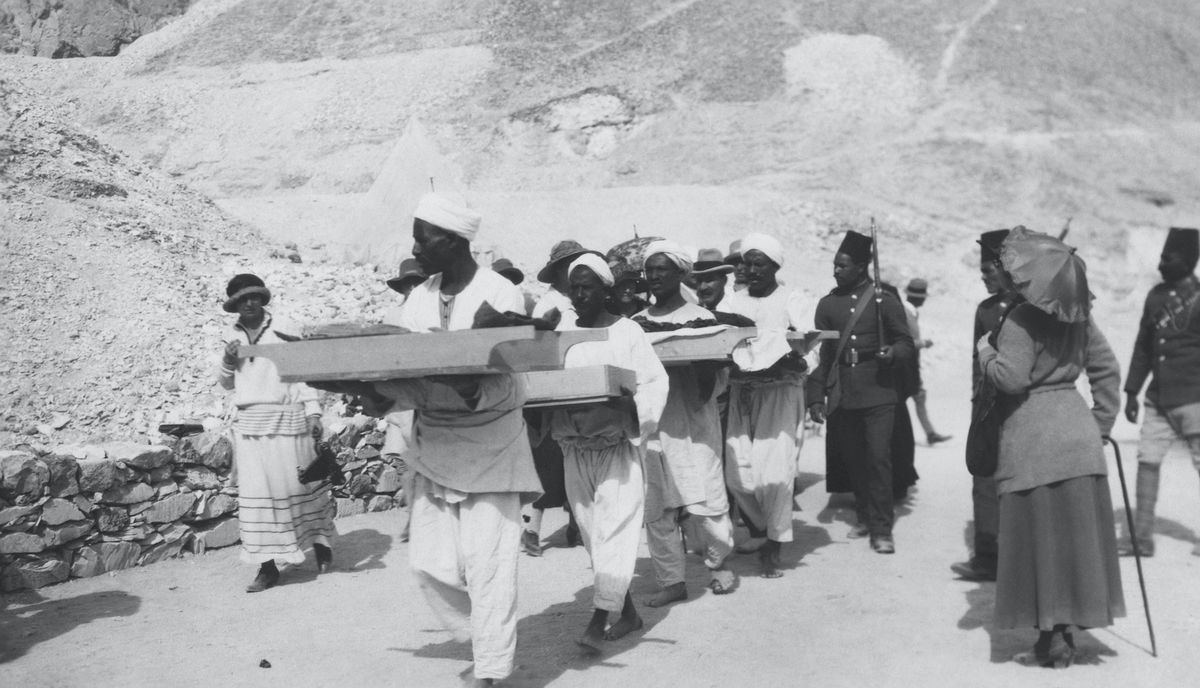British archaeologist Howard Carter is often credited with discovering Tutankhamun’s tomb, but the names and identities of the Egyptians who did much of the work are largely unknown.
Now on display”Tutankhamun: excavation of the archive (opens in a new tab)” at the Bodleian Libraries, University of Oxford, running until 5 February 2023, photographs of the Egyptians who discovered King Tutankhamun tombs are shown in an attempt to recognize them.
Photographs in the exhibition show how the Egyptians carried out most of the excavation, as well as an Egyptian doctor participating in the autopsy of Tutankhamun’s corpse. mummy. Another picture shows a boy with Tut ornaments, and another picture shows a group of Americans and Europeans. archaeologists sit down to dine near the excavation site while the Egyptians serve them.
According to the curators of the exhibition, the names of most of the Egyptians who excavated the tomb are unknown to us. “We only know the names of the four craftsmen Carter hired, as he calls them and thanks them in his publication,” Daniela Roznov (opens in a new tab), a project fellow at Oxford University’s Faculty of Asian and Middle Eastern Studies, told Live Science in an email. “They were Ahmed Gerigar, Gad Hassan, Hussein Abu Awad [and] Hussain Ahmed”.
On the subject: King Tutan, the boy soldier? Here’s what other stories don’t tell you.
We also know about Mohammed Saleh Hamdi Bey, an Egyptian physician who participated in Tutankhamun’s autopsy, and Hussein Abd el-Rasul, a water boy who, according to some stories, was the first or one of the first to find the tomb. In most cases, the curators of the exhibition could not identify the Egyptians in the photographs.
A number of Egyptologists told Live Science that Carter had a colonial mindset and did not treat Egyptians as equals. “I think he was insolent in general … not just against the Egyptian[s] but also against other nationalities,” Osama Gad, a tenured professor of papyrology and comparative literature at Ain Shams University in Cairo, told Live Science in an email. “He abused most of his team’s efforts and work.”
Zahi Hawass, Egypt’s former minister of antiquities, also noted that Carter mistreated the Egyptians. “One of Carter’s biggest mistakes was how he handled the Egyptians,” Hawass told Live Science in an email. “He did not allow Egyptian officials to visit the tomb, but planned to open the burial chamber and sarcophagus with his team and their wives.” Hawass noted that the incident increased tensions between Carter and Egypt’s then-Minister of Antiquities, Marcus Hanna, and Carter was forced to resign in 1924. After a change in the Egyptian government in 1925, Carter was allowed to resume work on the spot.
In 1922, Egypt declared independence from Great Britain, but Britain retained considerable influence. “For the Egyptians who fought for true independence, it was painful that Tutankhamun’s tomb was in the hands of foreigners,” Peter Der Manuelian (opens in a new tab)professor of Egyptology at Harvard University, wrote in his book “Walking Among the Pharaohs: George Reisner and the Dawn of Modern Egyptology (opens in a new tab)” (Oxford University Press, 2022).
Today, the Egyptians are leading and conducting major archaeological excavations, Hawass said. “Now our work and our excavations are admired by foreign teams,” said Khavas. “We are not against foreign teams, but we can compete.”
However, there are still cases where Egyptians stay away from foreigners. “I have written many times that the legacy of the colonial era is heavy on the ground, and what has been done in this century or more cannot be undone in a few years,” Gad said. “The rejection of Egyptians continues unabated.”
On the subject: 9 incredible treasures discovered in Tutankhamun’s tomb
Did the boy from the water open the tomb of Tutankhamun?
According to one story, the mentioned water boy Hussain found the grave. Hawass spoke with members of Rassoul’s family and told Live Science that he believed the story.
“A lot of people don’t believe this story,” he told Live Science in an email. “But I researched it, met his family, and I know it’s true.”
Hawass worked with the boy’s cousin, Sheikh Ali Abdul Rasool, who told Hawass how the events unfolded. Hussain was 12 years old and “his job was to bring water to the workers,” Hawass said. “People helped him pour water into a jar and then put the jars on a donkey to deliver to the workers. When he arrived on site, he and the workers dug pits to hold the jars. One day, while digging one of these jars, they found a grave!”
As a reward, Carter photographed Hussein with the necklaces from the tomb. Hawass said Hussein sometimes told the story to visitors near the Ramesseum, the funerary temple built for Pharaoh Ramses II.
However, not all scientists are convinced. Christina Riggs (opens in a new tab), a professor of the history of visual culture at Durham University in the UK, expressed caution. In 2020 blog post (opens in a new tab)she noted that the story appears to have been first published in 1978, when Thomas Hoving, director of the Metropolitan Museum of Art at the time, wrote about it in his book “Tutankhamun: The Untold Story (opens in a new tab)” (Simon & Schuster, 1978). Hoving got the story from an unpublished memoir written by Lee Kiddick, the New York agent who organized Howard Carter’s 1924 North American lecture tour.
Riggs’ research found that the photograph of the boy with Tutankhamun’s crown was taken in late 1926, “contrary to what Hussein and his family have repeatedly claimed, namely that he was 12 years old when the photograph was taken in 1922.”
Today, Egyptian-led archaeological teams are working across the country, with Hawass himself leading a team excavating the Valley of the Kings.
This article is first published on Source link




